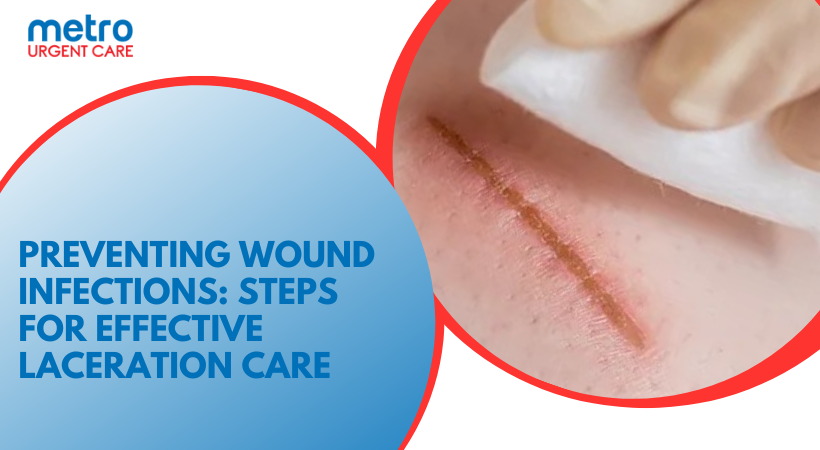


Lacerations are cuts or tears in the skin that occur for various reasons, such as accidents, sports injuries, or sharp objects. While many lacerations may seem minor, proper care is crucial to avoid infections and other complications.
Read on to explore effective laceration care, emphasizing the significance of each step in preventing wound infections.
A laceration is a break in the skin, often caused by a sharp object or blunt force. The severity of lacerations can vary, ranging from superficial cuts to deep wounds that may require medical attention.
Lacerations can occur in various settings, including:
Accidents: Falls, collisions, or mishaps at home or work are common culprits. For instance, tripping over a rug or slipping on a wet floor can result in cuts and scrapes.
Sports Injuries: Contact sports like football or hockey often lead to cuts and scrapes due to physical collisions or falls.
Household Items: Knives, broken glass, and tools can cause unintentional injuries during cooking, cleaning, or DIY projects. Even seemingly harmless items can pose a risk if not handled carefully.
Understanding these causes helps recognize the need for immediate deep laceration wound care.
When lacerations are not treated correctly, they can become infected. Infections develop when bacteria enter the wound. Studies show that untreated lacerations can lead to up to 15% infection rates. This emphasizes the importance of keeping the wound clean and following proper care guidelines to reduce this risk significantly.
Moreover, Complications arising from untreated lacerations include:
Delayed Healing: Infections can prolong recovery time, leaving the individual in discomfort for an extended period.
Increased Pain: An infected wound often causes more discomfort and can interfere with daily activities.
Abscess Formation: In severe cases, pockets of pus can develop, requiring medical intervention. If not addressed promptly, this can lead to further complications.
Timely and appropriate care is key to managing lacerations. By following a few important steps, you can ensure that wounds are treated effectively and safely.
Begin by evaluating the wound's severity. Is it deep? Does it involve significant bleeding? Primary care may suffice for minor cuts, but deeper lacerations may need medical attention, especially if the bleeding does not stop.
How to clean a laceration is a vital step in effective care. Follow these steps:
Wash your hands thoroughly with soap and water to prevent introducing more bacteria into the wound.
Rinse the laceration gently under cool running water to remove dirt and debris. This step helps clear away any foreign particles that could lead to infection.
Use mild soap around the area, but avoid getting soap directly into the wound, which can irritate.
After cleaning, an antiseptic solution is applied to the injury to eliminate bacteria. This step is crucial in preventing wound infections. Allow the disinfectant to dry completely before moving to the next step to ensure maximum efficacy.
Cover the laceration with a sterile bandage or dressing to shield it from further injury and contamination. Change the dressing daily or whenever it becomes wet or dirty. Regularly changing the dressing allows you to monitor the wound for any signs of infection.
Be vigilant for the following signs of infection:
Increased redness around the wound: This may indicate that the body is responding to a potential infection.
Swelling and warmth: These symptoms are signs of inflammation and may suggest that the wound is infected.
Pus or drainage: The presence of pus is a clear indication of infection, suggesting that bacteria multiply in the wound.
Fever and chills: A systemic response, such as fever, indicates that the body is fighting off an infection, which can be serious if left untreated.
Recognizing these symptoms early can help prevent complications. If you notice any signs of infection, seek medical attention promptly.
Professional intervention may be necessary to ensure proper healing and prevent further complications. Addressing potential infections early is crucial for effective laceration care.
To safeguard your healing journey and minimize the risk of infection, implementing effective preventative measures is essential:
Keeping the Wound Clean and Dry: Change the dressing regularly and avoid touching the wound with dirty hands.
Follow-up Care: If the laceration is deep or complex, follow your doctor's instructions for follow-up care.
Avoid Certain Activities: Avoid activities that could irritate or reopen the wound, such as strenuous exercise or contact sports.
Professional intervention, which may include laceration repair, may be necessary to ensure proper healing and prevent further complications. Addressing potential infections early is crucial for effective laceration care.
Proper laceration care is essential for preventing infections and promoting healing. By following the necessary precautions outlined above, you can significantly reduce the risk of complications. Always take laceration care seriously and seek medical advice when needed. A little extra effort in caring for your health today leads to a healthier tomorrow!
At Metro Urgent Care, our skilled team is ready to provide the comprehensive care you need for a speedy recovery. We focus on ensuring your wound heals appropriately while minimizing the risk of infection.
With our efficient and compassionate service, you’ll receive personalized attention that fits your needs. Contact us today to take the first step toward healing and reclaim your active lifestyle!